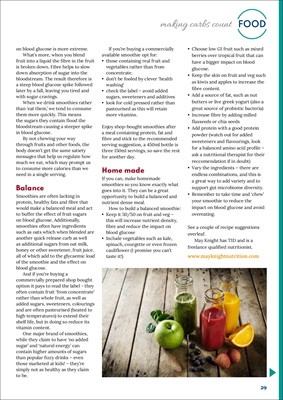
29
FOOD
making carbs count
on blood glucose is more extreme.
What's more, when you blend
fruit into a liquid the fibre in the fruit
is broken down. Fibre helps to slow
down absorption of sugar into the
bloodstream. The result therefore is
a steep blood glucose spike followed
later by a fall, leaving you tired and
with sugar cravings.
When we drink smoothies rather
than 'eat them,' we tend to consume
them more quickly. This means
the sugars they contain flood the
bloodstream causing a steeper spike
in blood glucose.
By not chewing your way
through fruits and other foods, the
body doesn't get the same satiety
messages that help us regulate how
much we eat, which may prompt us
to consume more calories than we
need in a single serving.
Balance
Smoothies are often lacking in
protein, healthy fats and fibre that
would make a balanced meal and act
to buffer the effect of fruit sugars
on blood glucose. Additionally,
smoothies often have ingredients
such as oats which when blended are
another quick release carb as well
as additional sugars from oat milk,
honey or other sweetener, fruit juice,
all of which add to the glycaemic load
of the smoothie and the effect on
blood glucose.
And if you're buying a
commercially prepared shop bought
option it pays to read the label - they
often contain fruit 'from concentrate'
rather than whole fruit, as well as
added sugars, sweeteners, colourings
and are often pasteurised (heated to
high temperatures) to extend their
shelf life, but in doing so reduce its
vitamin content.
One major brand of smoothies,
while they claim to have 'no added
sugar' and 'natural energy' can
contain higher amounts of sugars
than popular fizzy drinks - even
those marketed at kids! - they're
simply not as healthy as they claim
to be.
If you're buying a commercially
available smoothie opt for:
• those containing real fruit and
vegetables rather than from
concentrate.
• don't be fooled by clever 'health
washing'
• check the label - avoid added
sugars, sweeteners and additives
• look for cold pressed rather than
pasteurised as this will retain
more vitamins.
Enjoy shop-bought smoothies after
a meal containing protein, fat and
fibre and stick to the recommended
serving suggestion, a 450ml bottle is
three 150ml servings, so save the rest
for another day.
Home made
If you can, make homemade
smoothies so you know exactly what
goes into it. They can be a great
opportunity to build a balanced and
nutrient dense meal.
How to build a balanced smoothie:
• Keep it 50/50 on fruit and veg -
this will increase nutrient density,
fibre and reduce the impact on
blood glucose
• Include vegetables such as kale,
spinach, courgette or even frozen
cauliflower (I promise you can't
taste it!)
• Choose low GI fruit such as mixed
berries over tropical fruit that can
have a bigger impact on blood
glucose.
• Keep the skin on fruit and veg such
as kiwis and apples to increase the
fibre content.
• Add a source of fat, such as nut
butters or live greek yogurt (also a
great source of probiotic bacteria)
• Increase fibre by adding milled
flaxseeds or chia seeds
• Add protein with a good protein
powder (watch out for added
sweeteners and flavourings, look
for a balanced amino acid profile -
ask a nutritional therapist for their
reccomendation if in doubt)
• Vary the ingredients - there are
endless combinations, and this is
a great way to add variety and to
support gut microbiome diversity.
• Remember to take time and 'chew'
your smoothie to reduce the
impact on blood glucose and avoid
overeating.
See a couple of recipe suggestions
overleaf.
May Knight has Type 1 diabetes
and is a freelance qualified
nutritionist.